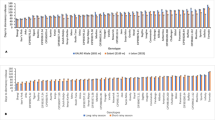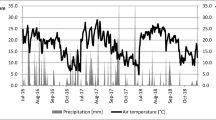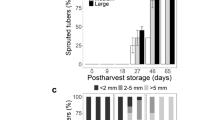Abstract
Comparisons were made of different methods of measuring length of the dormant period of Russet Burbank potato tubers as affected by time of planting and harvest. The study resulted in the following conclusions: 1) when measured from planting or tuber initiation to sprouting, the dormant period of tubers harvested on the same date was longer from an early planted crop than from a late planted crop. 2) When measured from harvest to sprouting, the dormant period was shorter for tubers from an early compared to a late planting. 3) With the same planting date and different harvest dates, when measured from planting or tuber initiation to sprouting, the dormant period was shorter for tubers from an early compared to a late harvest. 4) On the other hand, with the same planting date, when measured from time of harvest to sprouting, the dormant period was longer for tubers from an early compared to a late harvest. Planting date to sprouting was considered the best practical field measure of dormancy since it closely correlated with tuber initiation to sprouting, a method which was more accurate but difficult to determine. Both methods were much better than harvest date to sprouting which is commonly used. In addition, larger tubers from earlier planting had shorter dormancy than smaller tubers regardless of method of measurement due to a probable earlier set. From later plantings, tuber size had no relationship to length of dormancy. Moisture stress significantly reduced dormancy of Lemhi, Russet Burbank, and Nooksack but the Butte cultivar was only slightly affected.
Resumen
Fueron comparados diferentes métodos para medir la duración del período de latencia de tubérculos de la variedad Russet Burbank en relación con diferentes tiempos de plantación y cosecha. Se obtuvieron las siguientes conclusiones: (1) El período de latencia de tubérculos cosechados en el mismo día era más largo trat↭dose de un cultivo plantado más temprano que el de un cultivo plantado posteriormente cuando se medía desde el momento de la plantatión o de la iniciación de la tuberización hasta el momento de brotamiento. (2) Sin embargo, cuando se medía el tiempo de la cosecha al brotamiento, resultó más corto el periodo de latencia de los tubérculos de una plantación temprana comparado con el de tubérculos de una plantación tardía. (3) Al afectuar la medición del tiempo entre la plantación o la iniciación de tuberización y el brotamiento, contando con plantación en la misma fecha y cosecha de fechas diferentes, era más corto el período de latencia de los tubérculos de la cosecha temprana que el de los tubérculos de la cosecha tardía. (4) Por otro lado, partiendo de una misma fecha la plantación y midiendo el tiempo entre cosecha y brotamiento, era más largo el periodo de latencia de los tubérculos de la cosecha temprana que el de los tubérculos de la cosecha tardía. El período desde la siembra hasta el brotamiento fue considerado la mejor medida práctica de latencia pues se correlacionó estrechamente con el tiempo entre la iniciación de la tuberización y el brotamiento, método éste que fue más preciso pero más difícil de determinar. Ambos métodos resultaron mucho mejores que el del período entre cosecha y brotamiento, que es usado generalmente.
Además, en plantaciones tempranas los tubérculos más grandes tuvieron latencia más corta que los tubérculos más pequeños, sin importar el método de medición, debido a una probable adaptación temprana al medio. Con plantaciones tardías, no se encontró relación entre el tamaño del tubérculos y la duración de la latencia. La latencia de Lemhi, Russet Burbank y Nooksack se redujo significativamente en condiciones de estrés por humedad mientras que la variedad cultivada Butte sólo resultó ligeramente afectada.
Similar content being viewed by others
Literature Cited
Bogucki, S. and D.C. Nelson. 1980. Length of dormancy and sprouting characteristics of ten potato cultivars. Am Potato J 57:151–157.
Bruinsma, J. 1962. A survey of recent Japanese research on dormancy in potato tubers. Eur Potato J 5:195–203.
Burton, W.G. 1957. The dormancy and sprouting of potatoes. Fed Sci Abs 29:1–12.
-Burton, W.G.1961. The physiology of the potato: problems and present status. Proc 1st Trienn Conf Eur Assn Potato Res 1960. pp. 79–117.
— 1963a. Concepts and mechanism of dormancy. In “Growth of the Potato.” J.D. Ivins and F.L. Milthorpe, editors, pp. 17–41. Butterworth, London.
—1978. Breaking of dormancy and sprout growth. In The Potato Crop. P.M. Harris, editor. Chapman and Hall, London.
Clark, C.F. 1921. Development of tubers in the potato. US Dept Agric Bull 958.
Emilsson, B. 1949. Studies on the rest period and dormant period in the potato tuber. Acta Agric Suec 3:189–284.
Gray, D. 1973. The growth of individual tubers. Potato Res 16:80–84.
Hutchinson, R.W. 1978a. The dormancy of seed potatoes. 1. The effect of time of haulm destruction and harvesting. Potato Res 21:257–265.
Kolterman, A. 1927. Die Keimug der Kartoffelknolle and ihre Beeinflussung durch Krankheiten. Agnew Bot 9:289–339.
Loomis, W.E. 1927. Temperature and other factors affecting the rest period of potato tubers. Plant Physiol 2:287.
Pollock, B.M. 1953. The respiration of Acer buds in relation to the inception and termination of the winter rest. Physiol Planta 6:47–64.
Rosa, J.T. 1928. Relation of tuber maturity and of storage factors to potato dormancy. Hilgardia 3:99–124.
Samish, R.M. 1954. Dormancy in woody plants. Ann Rev Plant Physiol 5:183–204.
Wright, R.C. and W.M. Peacock. 1934. Influence of storage temperatures on the rest period and dormancy of potatoes. US Dept Agric Tech Bull 424.
Wurr, D.C.E. 1980. The influence of the specific gravity and node of origin of potato tubers on sprout growth. Potato Res 23:95–103.
Author information
Authors and Affiliations
Additional information
In partial fulfillment of the requirement for the Ph.D. degree, Dept. of Horticulture and Landscape Architecture. Scientific Paper No. SP 6234, College of Agriculture Research Center, Washington State Univ., Pullman WA 99164.
Former Graduate Assistant
Rights and permissions
About this article
Cite this article
Cho, J.L., Iritani, W.M. & Martin, M.W. Comparison of methods for measuring dormancy of potatoes. American Potato Journal 60, 169–177 (1983). https://doi.org/10.1007/BF02853998
Received:
Issue Date:
DOI: https://doi.org/10.1007/BF02853998




